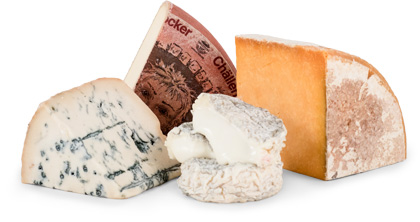As with many cheeses American palates favor, Edam is usually eaten young. At this stage its texture is elastic and supple, and the flavor is mild, smooth and nutty. However, the aged Edam we have shipped you is preferred by most cheese aficionados because it has a more robust and complex flavor, making for a taste that’s much more memorable.
Edam and Gouda are sometimes considered to have similar flavors but they’re different in a few ways. Edam is made from a combination of skimmed and part-skimmed cow’s milk so it has an eight to ten percent lower fat content. When Edam was first made it was traditional to skim off the fat from the evening’s milking and use the fat to make butter. The remaining skimmed milk was mixed with the next morning's milking to make a cheese that had a lower fat content and sharper flavor than Gouda. Another factor that contributes to its distinctive flavor is the milk itself, known the world over for its rich creaminess. The flavor of Dutch Edam is quite consistent because Dutch pastures are all at the same altitude and latitude; therefore, all Dutch cows eat pretty much the same thing. This is not the case in France, Italy and other countries, where the terrain and vegetation is much more varied. As a result, unique pasturelands offer the cows, sheep and goats many varieties of grasses and herbs which, in turn, bring about more variations in flavor. We think you will find that the genuine aged Edam we have selected is noticeably drier, lighter, and tarter than Gouda.
These days, Edam is produced all over the Netherlands. However, Edam's roots go back at least 600 years to the town of Edam in North Holland, which is renowned as an historically significant center of Dutch cheese exports. The town is a few miles north of Amsterdam, facing east across the waters of the old Zuider Zee, a tiny inlet of the North Sea. Edam is a city rich in history, dating back to the 12th century when farmers and fishermen settled along the Ye river, and named their town "Yedam." By the 17th century, this primitive settlement had become a prosperous town. Eventually, Edam had a great number of shipyards that turned out many famous ships, like the Halve Maan (Half Moon): the ship that Henry Hudson sailed in 1609 to look for a northern route to the East Indies, but ended up stranded on the island of Manhattan.
When Peter the Great of Russia decided that Russia needed a navy, he took an entourage of several hundred men to Holland to learn ship building from the world renowned Dutch master-craftsmen. After more than a year of study, he was awarded an official degree of excellence. Some historians claim that he took more pride in this diploma than he did in being Czar. No doubt he enjoyed many a cheese from the village of Edam that tasted exactly like the cheese you’re receiving this month.
Dutch global commercial expansion was also a major contributor to the thriving market for Edam. Today, the Dutch are sixth in the world when it comes to cheese production (sixty percent of what they make is Gouda). They are also the world's largest exporter of cheese.
Note of Interest: It appears that Edam can age for many years under certain conditions, and still be quite edible. The oldest Edam we know about was found at the South Pole in 1956. It had been left there in 1912 by the unfortunate Scott expedition.
Aged Edam is mild, slightly salty and nutty. We suggest pairing it with fruits such as peach, melon, apricot, pear and cherry. This cheese is good grated over potatoes, with bread, beer and wine. Dark beers and quality pinot noirs complement it especially well.

Experience International Variety
You might receive a Gaperon, originating in France during the 14th Century, an
authentic Lancashire by Ruth Kirkham, and an Italian Taleggio matured in the
caves of Valsassina…all in one shipment!

